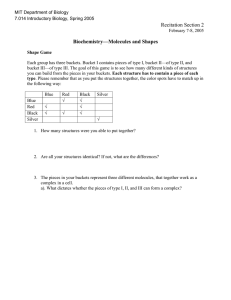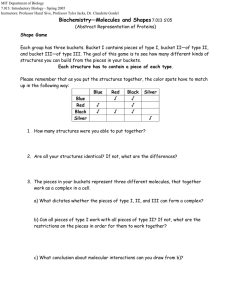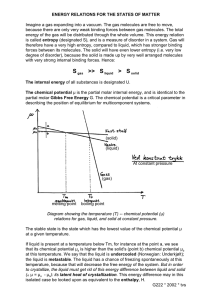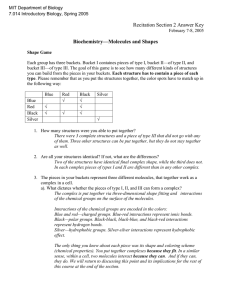MIT Department of Biology 7.013: Introductory Biology - Spring 2005
advertisement
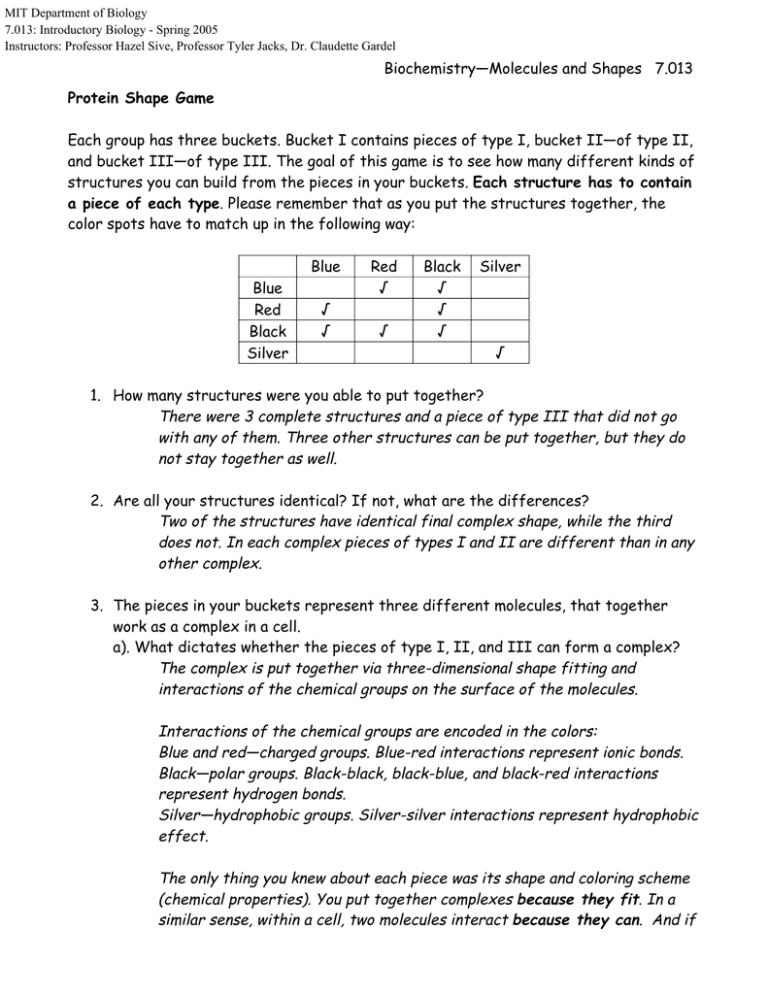
MIT Department of Biology 7.013: Introductory Biology - Spring 2005 Instructors: Professor Hazel Sive, Professor Tyler Jacks, Dr. Claudette Gardel Biochemistry—Molecules and Shapes 7.013 Protein Shape Game Each group has three buckets. Bucket I contains pieces of type I, bucket II—of type II, and bucket III—of type III. The goal of this game is to see how many different kinds of structures you can build from the pieces in your buckets. Each structure has to contain a piece of each type. Please remember that as you put the structures together, the color spots have to match up in the following way: Blue Blue Red Black Silver √ √ Red √ √ Black √ √ √ Silver √ 1. How many structures were you able to put together? There were 3 complete structures and a piece of type III that did not go with any of them. Three other structures can be put together, but they do not stay together as well. 2. Are all your structures identical? If not, what are the differences? Two of the structures have identical final complex shape, while the third does not. In each complex pieces of types I and II are different than in any other complex. 3. The pieces in your buckets represent three different molecules, that together work as a complex in a cell. a). What dictates whether the pieces of type I, II, and III can form a complex? The complex is put together via three-dimensional shape fitting and interactions of the chemical groups on the surface of the molecules. Interactions of the chemical groups are encoded in the colors: Blue and red—charged groups. Blue-red interactions represent ionic bonds. Black—polar groups. Black-black, black-blue, and black-red interactions represent hydrogen bonds. Silver—hydrophobic groups. Silver-silver interactions represent hydrophobic effect. The only thing you knew about each piece was its shape and coloring scheme (chemical properties). You put together complexes because they fit. In a similar sense, within a cell, two molecules interact because they can. And if they can, they do. We will return to discussing this point and its implications for the rest of this course at the end of the section. b). Can all pieces of type I work with all pieces of type II? If not, what are the restrictions on the pieces in order for them to work together? Each piece of type I only fits perfectly with one piece of type II. The other combinations do not work because the shapes of the type I and II pieces do not match each other. c).What conclusion about molecular interactions can you draw from b)? I. Molecular interactions are accomplished by 3D shape fitting and interactions of the chemical groups on the surface of the molecules. II. A change in the shape of a molecule can render it unable to interact with its binding partners. III. A complementary change in the shape of a binding partner molecule can restore binding (and function). 4. What is a protein? A protein is a biological macromolecule composed of one or more chains of amino acids in a specific order. 5. What are some of the other types of biological macromolecules in a cell? Other types of large molecules are nucleic acids (DNA and RNA), carbohydrates, and lipids. 6. What is the connection between these types of molecules in the cell? DNA encodes proteins through an RNA intermediate. Some RNAs also perform other functions in the cell. Proteins do a lot of different things in the cell, including making new DNA, RNA, carbohydrates, and lipids. 7. What are the four levels of protein structure? Primary—the sequence of amino acids; secondary—the local secondary structure (α−helices and β-sheets); tertiary—three-dimensional structure; and quarternary—interactions between 3D structures, such as multiple peptides within a protein complex. 8. If we consider our models to represent protein molecules, what level of protein structure do the models represent? Tertiary and quarternary. 9. What is the first level of protein structure at which a change that led to the pieces of the same type having different shapes would have occurred? Primary—change in amino acid sequence causes the change in the 3D conformation of a protein. 10. What are some of the different functions of proteins and protein complexes in a cell? Proteins perform many varied functions in the cell. Some examples are: antibodies binding an antigen, cell-to-cell signaling molecules binding to surface receptors, DNA polymerase synthesizing a new strand of DNA, lactase catalyzing the breakdown of lactose. Broad categories of function of proteins are: make stuff, break stuff down, transport stuff, signal or propagate the signal, create or anchor structures. These categories can be further broken down into many subcategories. Each team will now get a model of the binding pocket that the protein complex interacts with. 11. Can all your protein complex models fit into the pocket? No, one of the mutant complexes has an outer shape that excludes the ability to fit into the pocket. 12. 7.013 contains a number of different units, most corresponding to different disciplines in biology. Do you expect that learning about the principles behind molecular interactions today will help you with the material in the other units of the course? Why or why not? Understanding the principles behind molecular interactions will help you in all units of the course focusing on the molecular and cellular levels because: -Molecules interact because they can. -The only information in a cell is shape and chemical identities. -These are encoded in or determined by other molecules which themselves have shapes, and the “decoding” itself proceeds by the same mechanism of shape fitting. -Any other level at which we describe a biological system is an abstraction that ultimately must have an explanation on this basic level of shape fitting and interaction. -Ways to describe and study biological systems are ways to study properties of these interactions.
